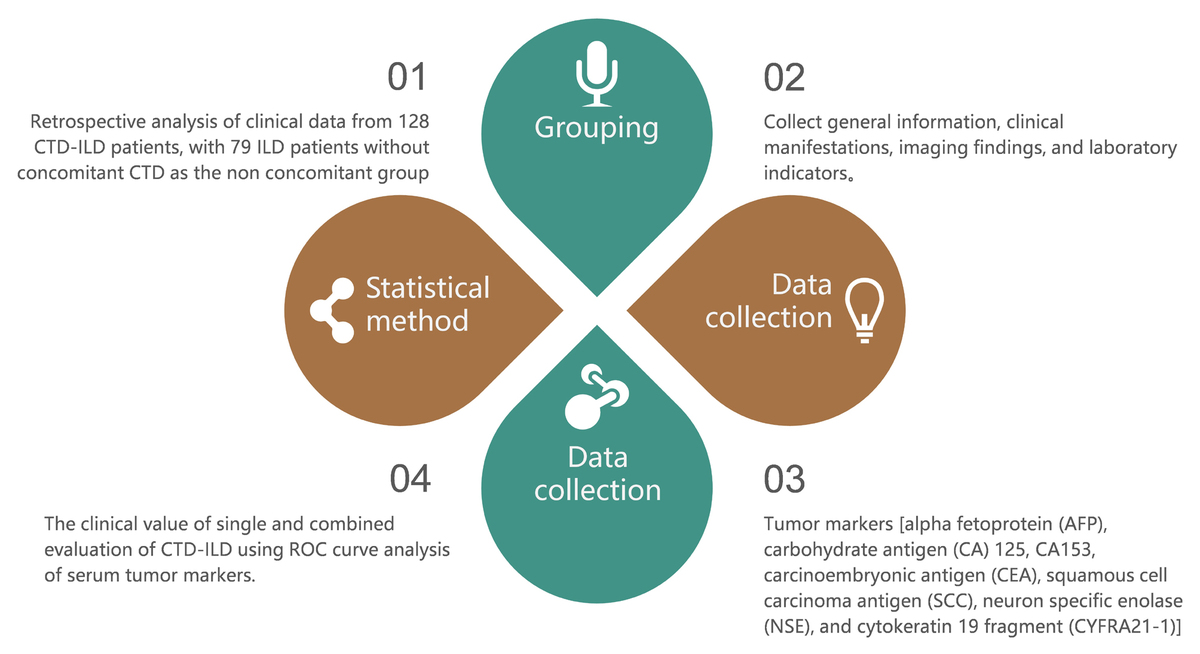Current issue
Archive
Manuscripts accepted
About the Journal
Editorial office
Editorial board
Section Editors
Abstracting and indexing
Subscription
Contact
Ethical standards and procedures
Most read articles
Instructions for authors
Article Processing Charge (APC)
Regulations of paying article processing charge (APC)
ONCOLOGY / RESEARCH PAPER
Relationship between Clinical Characteristics and Serum Tumor Markers in Connective Tissue Disease with Interstitial Lung Disease as the Initial Manifestation
1
Shanxi Bethune Hospital, China
These authors had equal contribution to this work
Submission date: 2024-05-27
Final revision date: 2025-04-19
Acceptance date: 2025-04-20
Online publication date: 2025-08-19
Corresponding author
KEYWORDS
TOPICS
ABSTRACT
Introduction:
Interstitial lung disease (ILD) is a common complication of connective tissue disease (CTD), which seriously affects the prognosis of patients. The abnormal expression of tumor markers in non-neoplastic diseases may be related to the occurrence and development of CTD-ILD. This study aimed to explore the detailed clinical characteristics of CTD-ILD, and to analyze its internal correlation with serum tumor markers.
Material and methods:
The clinical data of 128 patients with CTD-ILD were retrospectively analyzed. 79 of ILD patients without CTD were enrolled as the non-combined group. Clinical data included imaging manifestations, laboratory indexes and tumor markers such as carbohydrate antigen (CA) 125, CA153, carcinoembryonic antigen (CEA), neuron-specific enolase (NSE) and squamous cell carcinoma (SCC) antigen were collected. ROC curve was used to analyze the clinical value.
Results:
The proportion of clinical manifestations such as arthralgia, rash, Raynaud’s phenomenon, dry mouth and dry eyes in the combined group was higher than the non-combined group (P < 0.05). The serum albumin and total protein levels in the combined group were lower than the non-combined group (P < 0.001). The levels of CA125, CA153, CEA, SCC and NSE in the combined group were higher than the non-combined group (P < 0.001). The AUC of combined detection of each index was 0.917, with a sensitivity of 97.47% and a specificity of 76.56%.
Conclusions:
The main clinical manifestations for CTD-ILD patients were arthralgia, rash, Raynaud’s phenomenon, dry mouth and eyes. The combined detection of tumor markers had a high evaluation value.
Interstitial lung disease (ILD) is a common complication of connective tissue disease (CTD), which seriously affects the prognosis of patients. The abnormal expression of tumor markers in non-neoplastic diseases may be related to the occurrence and development of CTD-ILD. This study aimed to explore the detailed clinical characteristics of CTD-ILD, and to analyze its internal correlation with serum tumor markers.
Material and methods:
The clinical data of 128 patients with CTD-ILD were retrospectively analyzed. 79 of ILD patients without CTD were enrolled as the non-combined group. Clinical data included imaging manifestations, laboratory indexes and tumor markers such as carbohydrate antigen (CA) 125, CA153, carcinoembryonic antigen (CEA), neuron-specific enolase (NSE) and squamous cell carcinoma (SCC) antigen were collected. ROC curve was used to analyze the clinical value.
Results:
The proportion of clinical manifestations such as arthralgia, rash, Raynaud’s phenomenon, dry mouth and dry eyes in the combined group was higher than the non-combined group (P < 0.05). The serum albumin and total protein levels in the combined group were lower than the non-combined group (P < 0.001). The levels of CA125, CA153, CEA, SCC and NSE in the combined group were higher than the non-combined group (P < 0.001). The AUC of combined detection of each index was 0.917, with a sensitivity of 97.47% and a specificity of 76.56%.
Conclusions:
The main clinical manifestations for CTD-ILD patients were arthralgia, rash, Raynaud’s phenomenon, dry mouth and eyes. The combined detection of tumor markers had a high evaluation value.
We process personal data collected when visiting the website. The function of obtaining information about users and their behavior is carried out by voluntarily entered information in forms and saving cookies in end devices. Data, including cookies, are used to provide services, improve the user experience and to analyze the traffic in accordance with the Privacy policy. Data are also collected and processed by Google Analytics tool (more).
You can change cookies settings in your browser. Restricted use of cookies in the browser configuration may affect some functionalities of the website.
You can change cookies settings in your browser. Restricted use of cookies in the browser configuration may affect some functionalities of the website.



